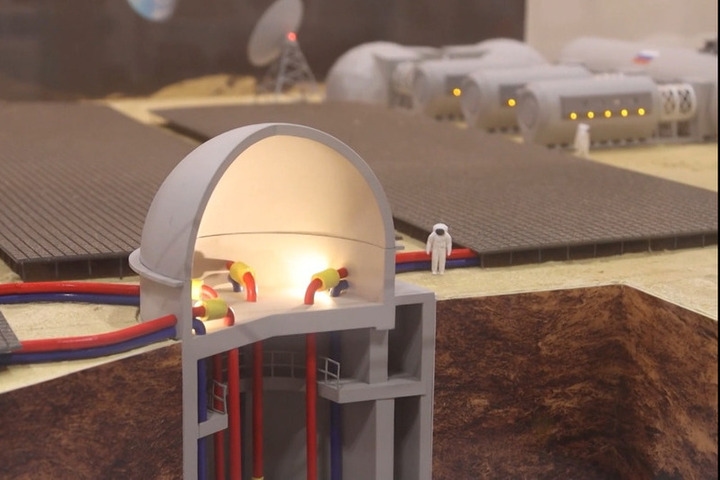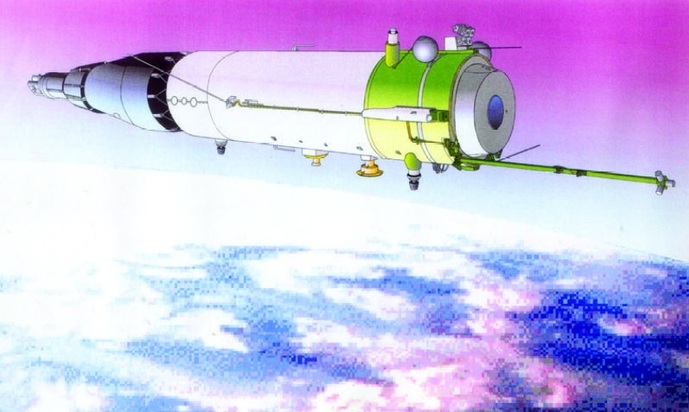Without turbines: experts reveal details of the creation of a future nuclear power plant on the Moon

The head of the Kurchatov Institute Mikhail Kovalchuk recently spoke about the details of the creation of a nuclear power plant on the Moon and what name they are planning to give it. The prototype for this power facility will be the low-power nuclear power plant "Elena-AM" for the harsh Yakut climate, which, however, is still at the design stage.
As MK reported earlier, the president recently approved a 10-year national project for the development of cosmonautics until 2036. It includes a section on the exploration of the Moon as the first stage in the further conquest of outer space. According to a number of experts, it cannot be accomplished without the use of nuclear energy. The argument cited is that solar batteries can run out of power on the surface of our satellite during just one lunar night, which lasts 14 days.
According to Roscosmos, Russian specialists plan to create the first ever extraterrestrial planetary nuclear power plant together with China by 2036.
Mikhail Kovalchuk spoke about one of the projects that the Russian side will undertake in his authorial program "Picture of the World". We are talking about a reactor for the first on-planet power plant, the prototype for which will be the "Elena" NPP, which is being developed for Yakutia.
"The Kurchatov Institute already has a project for a low-power nuclear power plant, "Elena-AM", for the harsh climate of the Yakut village of Tiksi. On this basis, scientists have developed a project for a lunar nuclear power plant, "Selena", " the head of the Kurchatov Institute said.
This would be nice, but it is not yet clear when the "Elena-AM" itself will appear - "a compact and simplified design of a mini-NPP, distinguished by high reliability and not requiring the constant presence of maintenance personnel." The model is still at the design stage...
Meanwhile, according to the corresponding member of the Russian Academy of Sciences Alexey Kovalishin, the creation of a space nuclear power plant is a very complex matter and no one has managed it yet. But still, our developers are confident that they will cope with it, given the fact that until now no country, except ours, albeit from the times of the USSR, had flight models of onboard nuclear power plants. "We have gained rich experience of their use in space from the 60s to the beginning of the 90s, we still have the technology, and therefore we have no doubt that we will create a new source of energy for the Moon," said Kovalishin.

The specialist from the Scientific Research Center "KI" also revealed some technological features of the future lunar NPP. According to him, it will not have a water coolant, but a liquid metal coolant: it does not boil and does not create high pressure. The station will also not have turbines or other mechanisms that would require regular maintenance and repair. The specialist did not report on the timing of the creation of a lunar NPP prototype for testing.
By the way, about those very flights from the 60s to the 90s... According to Mikhail Kovalchuk, we alone have 32 flight models of satellites (the "Cosmos" series), which flew for almost 20 years with nuclear power plants on board.
It all started with a small-sized thermoelectric installation called "Romashka" (Daisy), 35 centimeters high. It did not rise into space, but became a prototype for other nuclear power plants, such as "Buk", used in naval reconnaissance. Then "Topaz" appeared, which could work in orbit for 12 months (twice as long as "Buk"), and then "Yenisei" with a three-year service life appeared. These prototypes are planned to be improved and used in further space exploration.
While we have the technologies, while those who used them are still alive, we need to restore everything - this is a fact, otherwise it will be very difficult for young designers to implement them based on technical documentation alone. But everything depends on the goals - what might nuclear power plants be needed for now? The only and most discussed goal for a nuclear space engine so far is only a flight to Mars.
Russia can develop an interplanetary nuclear tug to deliver up to 10 tons of payload from near-Earth to near-Mars orbit – we have heard this more than once from officials in the space industry.
According to the CEO of Roscosmos, the tug is needed primarily to send cargo to the Red Planet, from which infrastructure will be created on the surface of Mars before people arrive there. The tug is not suitable for the manned version, since its trajectory to Mars will pass through radiation fields that can have a serious negative impact on the human body.
So, let's leave Mars and the nuclear tug alone for now and return to the lunar station, which, let me remind you, Russia and China plan to launch within the next 10 years. China, as is well known, carries out its plans with enviable consistency, and therefore now the moment of truth has arrived for our space functionaries: if they fail to fulfill their promises by the stated deadlines, the Chinese may look for others.
By the way, we are used to talking and writing about the "Russian-Chinese project". But our Chinese colleagues at best call it "Chinese-Russian", or even "Chinese". The foreign press issues the following theses: "China plans to deploy a mini-NPP on the Moon", "Russia, which is developing a compact nuclear reactor, will be a likely partner of the project".
It's high time, as they say, to synchronize our watches. So, according to a presentation made in April 2025 by Chinese engineers in Shanghai, the PRC intends to create a lunar base after 2030. As part of the Chang'e-8 mission, planned for 2028, a landing vehicle with a lunar rover and a robot will be sent to the Moon. Then they will start deploying a base with a nuclear reactor. By the way, according to engineer Pei Zhao Yu, the solution with a nuclear station has its drawbacks, for example, the need to remove heat, which, in the absence of an atmosphere on the Moon, can lead to additional problems, such as overheating of radiators.
Yes, our engineer Alexey Kovalishin is right, creating a nuclear power plant on the Moon is an extremely complex matter, but let's hope that our scientists really do have all the necessary competencies to implement this.
MK Reference: 13 countries have already joined the ILS initiative (creation of an international scientific lunar station). Among them are Azerbaijan, Belarus, Bolivia, Venezuela, Djibouti, Egypt, Nicaragua, Pakistan, Senegal, Serbia, Thailand, Ethiopia, and the Republic of South Africa. The parameters and conditions of future cooperation, as well as the contribution each country will make to this matter, are still being discussed.
mk.ru




